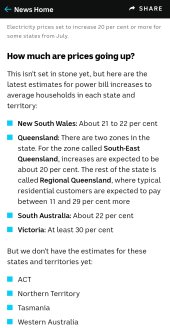Interesting. So it's like here in the US where a larger commercial business may be subject to demand pricing based on rolling 30 minute intervals, but in reverse for exports to the grid.
Sounds similar. The key difference is these are not charges levied directly onto a customer, but by the distribution company to the retailer who "owns" the customer. It's entirely up to retailers how they price their retail electricity plans for customers.
As a rule of thumb retailers tend to offer a single "feed-in tariff" (FIT) and they absorb the risk of the ups and downs with the wholesale value of that energy, plus any carbon offset value it represents for them. They could introduce a new fee/charge, however the more complex they make their plans the less appealing they are for customers to purchase from them and they will churn elsewhere.
I expect we will still have a non-negative FIT, it just may be a little lower than it otherwise might have been (and it's not worth a lot now so it's really no big deal).
I doubt we'll have retail level peak export charges but it is all very much an unknown at this time. We are however increasingly seeing peak demand charges (in return for lower consumption tariffs). Complicating all of this is the mix of energy meters we have on the grid. they are gradually being replaced by smarter devices which auto upload to the metering company. Anyone installing solar PV must have their meter upgraded, as well as all new connections and any approved changes to supply, or when a meter fails and needs replacement
The other thing to note here is distribution company income is highly regulated (being natural monopolies). If they make more revenue from one aspect of operation (e.g. charging for exports to the grid), then they are required by law to offset that via reduced income elsewhere. In general that means a commensurate reduction in income from fixed daily charges and/or their consumption tariffs. Under this change they are also required to improve their infrastructure to enable the grid to handle more distributed solar PV.


 www.abc.net.au
www.abc.net.au



